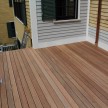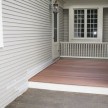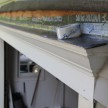Sealing Wood End Grain

On decks or porches you can seal all rip cuts as they are installed and seal the end grain after the decking in in place.
Painting Wood End Grain
The end cuts in siding, deck boards and trim all need to be sealed at installation.
The biggest reason for sealing wood end grain is because the wood end grain is exposed on an end cut and it absorbs liquids up to 250 times more rapidly than other wood surfaces.
Why Sealing End Grain Is Important
Grab a bunch of straws and hold them together – that is how I envision wood end grain. These tiny straws wick up moisture over time from rain, snow and roof splash off.
The days of old growth lumber, “bullet proof” lead paint, and leaky breathable house walls are gone. All of these things help prevent or slow wood rot.
Today’s wood is different and not as insect and rot resistant, the paint is not nearly as durable and houses are constructed so tight that sidewall moisture problems are prevalent.
By sealing and back priming all wood trim or decking you are giving the trim or decking a better chance to endure the elements by slowing water infiltration.
Wood trim often rots due to improper installation methods, and from not priming or painting the end grain. Trim wood exposed to the elements soak up water which start the rotting process.
Wood trim should be installed:
- Decoupled from the masonry with flashing or an air gap
- Installed with an air gap spaced off a roof, masonry or the ground
Wood trim and decking should:
- Siding should have proper joint flashing
- Decking should have adequate spacing for drainage and air flow
- All wood sealed on all six sides
Seal End Grain At Installation
A Better Product Lasts Longer
Best practices dictate sealing wood end grain – it doesn’t add on much time, just like adding strips of building paper behind the joints ad results in a better quality, longer lasting installation.











